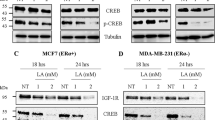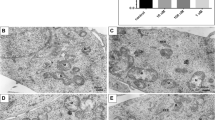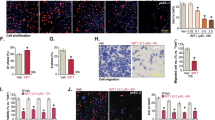Abstract
2-Methoxyestradiol (2-ME), an endogenous estrogen metabolite of 17β-estradiol, is known to induce mitochondria-mediated apoptosis through several mechanisms. We sought to study the effect of mitochondrialy _targeted hOGG1 (MTS-hOGG1) on HeLa cells exposed to 2-ME. MTS-hOGG1-expressing cells exposed to 2-ME showed increased cellular survival and had significantly less G2/M cell cycle arrest compared to vector-only-transfected cells. In addition, 2-ME exposure resulted in an increase in mitochondrial membrane potential, increased apoptosis, accompanied by higher activation of caspase-3, -9, cleavage of Bid to tBid and protein poly(ADP-ribose) polymerase (PARP) cleavage in HeLa cells lacking MTS-hOGG1. Fas inhibitors cerulenin or C75 inhibited 2-ME-induced caspase activation, PARP cleavage, apoptosis and reversed mitochondrial membrane hyperpolarization, thereby recapitulating the increased expression of MTS-hOGG1. Hence, MTS-hOGG1 plays an important protective role against 2-ME-mediated mitochondrial damage by blocking apoptosis induced through the Fas pathway.
This is a preview of subscription content, access via your institution
Access options
Subscribe to this journal
Receive 50 print issues and online access
We are sorry, but there is no personal subscription option available for your country.
Buy this article
- Purchase on SpringerLink
- Instant access to full article PDF
Prices may be subject to local taxes which are calculated during checkout








Similar content being viewed by others
References
Achanta G, Huang P . (2004). Role of p53 in sensing oxidative DNA damage in response to reactive oxygen species-generating agents. Cancer Res 64: 6233–6239.
Alley MC, Scudiero DA, Monks A, Hursey ML, Czerwinski MJ, Fine DL et al. (1988). Feasibility of drug screening with panels of human tumor cell lines using a microculture tetrazolium assay. Cancer Res 48: 589–601.
Audebert M, Charbonnier JB, Boiteux S, Radicella JP . (2002). Mitochondrial _targeting of human 8-oxoguanine DNA glycosylase hOGG1 is impaired by a somatic mutation found in kidney cancer. DNA Repair (Amst) 1: 497–505.
Banki K, Hutter E, Gonchoroff NJ, Perl A . (1999). Elevation of mitochondrial transmembrane potential and reactive oxygen intermediate levels are early events and occur independently from activation of caspases in Fas signaling. J Immunol 162: 1466–1479.
Blaisdell JO, Wallace SS . (2001). Abortive base-excision repair of radiation-induced clustered DNA lesions in Escherichia coli. Proc Natl Acad Sci USA 98: 7426–7430.
Bohr VA, Stevnsner T, De Souza-Pinto NC . (2002). Mitochondrial DNA repair of oxidative damage in mammalian cells. Gene 286: 127–134.
Cadet J, Berger M, Douki T, Ravanat JL . (1997). Oxidative damage to DNA: formation, measurement, and biological significance. Rev Physiol Biochem Pharmacol 131: 1–87.
Chatterjee A, Mambo E, Zhang Y, Deweese T, Sidransky D . (2006). _targeting of mutant hogg1 in mammalian mitochondria and nucleus: effect on cellular survival upon oxidative stress. BMC Cancer 6: 235.
Cheng KC, Cahill DS, Kasai H, Nishimura S, Loeb LA . (1992). 8-Hydroxyguanine, an abundant form of oxidative DNA damage, causes G- - - -T and A- - - -C substitutions. J Biol Chem 267: 166–172.
Chi NW, Kolodner RD . (1994). Purification and characterization of MSH1, a yeast mitochondrial protein that binds to DNA mismatches. J Biol Chem 269: 29984–29992.
Corral-Debrinski M, Horton T, Lott MT, Shoffner JM, McKee AC, Beal MF et al. (1994). Marked changes in mitochondrial DNA deletion levels in Alzheimer brains. Genomics 23: 471–476.
Davis RE, Miller S, Herrnstadt C, Ghosh SS, Fahy E, Shinobu LA et al. (1997). Mutations in mitochondrial cytochrome c oxidase genes segregate with late-onset Alzheimer disease. Proc Natl Acad Sci USA 94: 4526–4531.
Dhenaut A, Boiteux S, Radicella JP . (2000). Characterization of the hOGG1 promoter and its expression during the cell cycle. Mutat Res 461: 109–118.
Dhenaut A, Hollenbach S, Eckert I, Epe B, Boiteux S, Radicella JP . (2001). Characterization of hOGG1 promoter structure, expression during cell cycle and overexpression in mammalian cells. Adv Exp Med Biol 500: 613–616.
Dianov GL, Souza-Pinto N, Nyaga SG, Thybo T, Stevnsner T, Bohr VA . (2001). Base excision repair in nuclear and mitochondrial DNA. Prog Nucleic Acid Res Mol Biol 68: 285–297.
Dizdaroglu M . (1991). Chemical determination of free radical-induced damage to DNA. Free Radic Biol Med 10: 225–242.
Djavaheri-Mergny M, Wietzerbin J, Besancon F . (2003a). 2-Methoxyestradiol induces apoptosis in Ewing sarcoma cells through mitochondrial hydrogen peroxide production. Oncogene 22: 2558–2567.
Djavaheri-Mergny M, Wietzerbin J, Rouillard D, Besancon F . (2003b). TNFalpha potentiates 2-methoxyestradiol-induced mitochondrial death pathway. Ann NY Acad Sci 1010: 159–162.
Dobson AW, Xu Y, Kelley MR, LeDoux SP, Wilson GL . (2000). Enhanced mitochondrial DNA repair and cellular survival after oxidative stress by _targeting the human 8-oxoguanine glycosylase repair enzyme to mitochondria. J Biol Chem 275: 37518–37523.
Druzhyna NM, Hollensworth SB, Kelley MR, Wilson GL, Ledoux SP . (2003). _targeting human 8-oxoguanine glycosylase to mitochondria of oligodendrocytes protects against menadione-induced oxidative stress. Glia 42: 370–378.
Druzhyna NM, Musiyenko SI, Wilson GL, LeDoux SP . (2005). Cytokines induce nitric oxide-mediated mtDNA damage and apoptosis in oligodendrocytes. Protective role of _targeting 8-oxoguanine glycosylase to mitochondria. J Biol Chem 280: 21673–21679.
Dubey RK, Gillespie DG, Jackson EK, Keller PJ . (1998). 17Beta-estradiol, its metabolites, and progesterone inhibit cardiac fibroblast growth. Hypertension 31: 522–528.
Fanizza C, Ursini CL, Paba E, Ciervo A, Di Francesco A, Maiello R et al. (2007). Cytotoxicity and DNA-damage in human lung epithelial cells exposed to respirable alpha-quartz. Toxicol In Vitro 21: 586–594.
Fishel ML, Seo YR, Smith ML, Kelley MR . (2003). Imbalancing the DNA base excision repair pathway in the mitochondria; _targeting and overexpressing N-methylpurine DNA glycosylase in mitochondria leads to enhanced cell killing. Cancer Res 63: 608–615.
Gao N, Rahmani M, Dent P, Grant S . (2005). 2-Methoxyestradiol-induced apoptosis in human leukemia cells proceeds through a reactive oxygen species and Akt-dependent process. Oncogene 24: 3797–3809.
Grollman AP, Moriya M . (1993). Mutagenesis by 8-oxoguanine: an enemy within. Trends Genet 9: 246–249.
Gui Y, Zheng XL . (2006). 2-Methoxyestradiol induces cell cycle arrest and mitotic cell apoptosis in human vascular smooth muscle cells. Hypertension 47: 271–280.
Hagen T, D'Amico G, Quintero M, Palacios-Callender M, Hollis V, Lam F et al. (2004). Inhibition of mitochondrial respiration by the anticancer agent 2-methoxyestradiol. Biochem Biophys Res Commun 322: 923–929.
Hazra TK, Hill JW, Izumi T, Mitra S . (2001). Multiple DNA glycosylases for repair of 8-oxoguanine and their potential in vivo functions. Prog Nucleic Acid Res Mol Biol 68: 193–205.
Huang P, Feng L, Oldham EA, Keating MJ, Plunkett W . (2000). Superoxide dismutase as a _target for the selective killing of cancer cells. Nature 407: 390–395.
Hutchin T, Cortopassi G . (1995). A mitochondrial DNA clone is associated with increased risk for Alzheimer disease. Proc Natl Acad Sci USA 92: 6892–6895.
Ide H, Kotera M . (2004). Human DNA glycosylases involved in the repair of oxidatively damaged DNA. Biol Pharm Bull 27: 480–485.
Itoh K, Hase H, Kojima H, Saotome K, Nishioka K, Kobata T . (2004). Central role of mitochondria and p53 in Fas-mediated apoptosis of rheumatoid synovial fibroblasts. Rheumatology (Oxford) 43: 277–285.
Kachadourian R, Liochev SI, Cabelli DE, Patel MN, Fridovich I, Day BJ . (2001). 2-Methoxyestradiol does not inhibit superoxide dismutase. Arch Biochem Biophys 392: 349–353.
Krokan HE, Nilsen H, Skorpen F, Otterlei M, Slupphaug G . (2000). Base excision repair of DNA in mammalian cells. FEBS Lett 476: 73–77.
Lambert C, Apel K, Biesalski HK, Frank J . (2004). 2-Methoxyestradiol induces caspase-independent, mitochondria-centered apoptosis in DS-sarcoma cells. Int J Cancer 108: 493–501.
Lambert C, Thews O, Biesalski HK, Vaupel P, Kelleher DK, Frank J . (2002). 2-Methoxyestradiol enhances reactive oxygen species formation and increases the efficacy of oxygen radical generating tumor treatment. Eur J Med Res 7: 404–414.
LaVallee TM, Zhan XH, Johnson MS, Herbstritt CJ, Swartz G, Williams MS et al. (2003). 2-Methoxyestradiol up-regulates death receptor 5 and induces apoptosis through activation of the extrinsic pathway. Cancer Res 63: 468–475.
Li L, Bu S, Backstrom T, Landstrom M, Ulmsten U, Fu X . (2004a). Induction of apoptosis and G2/M arrest by 2-methoxyestradiol in human cervical cancer HeLaS3 cells. Anticancer Res 24: 873–880.
Li L, Heldin NE, Grawe J, Ulmsten U, Fu X . (2004b). Induction of apoptosis or necrosis in human endometrial carcinoma cells by 2-methoxyestradiol. Anticancer Res 24: 3983–3990.
Lightowlers RN, Chinnery PF, Turnbull DM, Howell N . (1997). Mammalian mitochondrial genetics: heredity, heteroplasmy and disease. Trends Genet 13: 450–455.
Mambo E, Chatterjee A, De Souza-Pinto NC, Mayard S, Hogue BA, Hoque MO et al. (2005). Oxidized guanine lesions and hOgg1 activity in lung cancer. Oncogene 24: 4496–4508.
Mambo E, Nyaga SG, Bohr VA, Evans MK . (2002). Defective repair of 8-hydroxyguanine in mitochondria of MCF-7 and MDA-MB-468 human breast cancer cell lines. Cancer Res 62: 1349–1355.
Michaels ML, Miller JH . (1992). The GO system protects organisms from the mutagenic effect of the spontaneous lesion 8-hydroxyguanine (7,8-dihydro-8-oxoguanine). J Bacteriol 174: 6321–6325.
Michaels ML, Tchou J, Grollman AP, Miller JH . (1992). A repair system for 8-oxo-7,8-dihydrodeoxyguanine. Biochemistry 31: 10964–10968.
Modica-Napolitano JS, Koya K, Weisberg E, Brunelli BT, Li Y, Chen LB . (1996). Selective damage to carcinoma mitochondria by the rhodacyanine MKT-077. Cancer Res 56: 544–550.
Mooberry SL . (2003). Mechanism of action of 2-methoxyestradiol: new developments. Drug Resist Updat 6: 355–361.
Morgunov I, Srere PA . (1998). Interaction between citrate synthase and malate dehydrogenase. Substrate channeling of oxaloacetate. J Biol Chem 273: 29540–29544.
Moriya M, Ou C, Bodepudi V, Johnson F, Takeshita M, Grollman AP . (1991). Site-specific mutagenesis using a gapped duplex vector: a study of translesion synthesis past 8-oxodeoxyguanosine in E.coli. Mutat Res 254: 281–288.
Nabi ZF, Zucker-Franklin D, Lipkin G, Rosenberg M . (1986). Susceptibility to NK cell lysis is abolished in tumor cells by a factor which restores their contact inhibited growth. Cancer 58: 1461–1465.
Pani G, Bedogni B, Anzevino R, Colavitti R, Palazzotti B, Borrello S et al. (2000). Deregulated manganese superoxide dismutase expression and resistance to oxidative injury in p53-deficient cells. Cancer Res 60: 4654–4660.
Parlanti E, Fortini P, Macpherson P, Laval J, Dogliotti E . (2002). Base excision repair of adenine/8-oxoguanine mispairs by an aphidicolin-sensitive DNA polymerase in human cell extracts. Oncogene 21: 5204–5212.
Pelicano H, Feng L, Zhou Y, Carew JS, Hileman EO, Plunkett W et al. (2003). Inhibition of mitochondrial respiration: a novel strategy to enhance drug-induced apoptosis in human leukemia cells by a reactive oxygen species-mediated mechanism. J Biol Chem 278: 37832–37839.
Planas-Silva MD, Weinberg RA . (1997). Estrogen-dependent cyclin E-cdk2 activation through p21 redistribution. Mol Cell Biol 17: 4059–4069.
Qanungo S, Basu A, Das M, Haldar S . (2002). 2-Methoxyestradiol induces mitochondria dependent apoptotic signaling in pancreatic cancer cells. Oncogene 21: 4149–4157.
Rachek LI, Grishko VI, Ledoux SP, Wilson GL . (2006a). Role of nitric oxide-induced mtDNA damage in mitochondrial dysfunction and apoptosis. Free Radic Biol Med 40: 754–762.
Rachek LI, Grishko VI, Musiyenko SI, Kelley MR, LeDoux SP, Wilson GL . (2002). Conditional _targeting of the DNA repair enzyme hOGG1 into mitochondria. J Biol Chem 277: 44932–44937.
Rachek LI, Thornley NP, Grishko VI, LeDoux SP, Wilson GL . (2006b). Protection of INS-1 cells from free fatty acid-induced apoptosis by _targeting hOGG1 to mitochondria. Diabetes 55: 1022–1028.
Reers M, Smith TW, Chen LB . (1991). J-aggregate formation of a carbocyanine as a quantitative fluorescent indicator of membrane potential. Biochemistry 30: 4480–4486.
Rinne ML, He Y, Pachkowski BF, Nakamura J, Kelley MR . (2005). N-methylpurine DNA glycosylase overexpression increases alkylation sensitivity by rapidly removing non-toxic 7-methylguanine adducts. Nucleic Acids Res 33: 2859–2867.
Ruchko M, Gorodnya O, LeDoux SP, Alexeyev MF, Al-Mehdi AB, Gillespie MN . (2005). Mitochondrial DNA damage triggers mitochondrial dysfunction and apoptosis in oxidant-challenged lung endothelial cells. Am J Physiol Lung Cell Mol Physiol 288: L530–L535.
Salvioli S, Ardizzoni A, Franceschi C, Cossarizza A . (1997). JC-1, but not DiOC6(3) or rhodamine 123, is a reliable fluorescent probe to assess delta psi changes in intact cells: implications for studies on mitochondrial functionality during apoptosis. FEBS Lett 411: 77–82.
Schapira AH . (1999). Mitochondrial involvement in Parkinson's disease, Huntington's disease, hereditary spastic paraplegia and Friedreich's ataxia. Biochim Biophys Acta 1410: 159–170.
Segal-Bendirdjian E, Coulaud D, Roques BP, Le Pecq JB . (1988). Selective loss of mitochondrial DNA after treatment of cells with ditercalinium (NSC 335153), an antitumor bis-intercalating agent. Cancer Res 48: 4982–4992.
Shimada K, Nakamura M, Ishida E, Kishi M, Matsuyoshi S, Konishi N . (2004). The molecular mechanism of sensitization to Fas-mediated apoptosis by 2-methoxyestradiol in PC3 prostate cancer cells. Mol Carcinog 39: 1–9.
Shokolenko IN, Alexeyev MF, Robertson FM, LeDoux SP, Wilson GL . (2003). The expression of Exonuclease III from E.coli in mitochondria of breast cancer cells diminishes mitochondrial DNA repair capacity and cell survival after oxidative stress. DNA Repair (Amst) 2: 471–482.
Singh KK, Russell J, Sigala B, Zhang Y, Williams J, Keshav KF . (1999). Mitochondrial DNA determines the cellular response to cancer therapeutic agents. Oncogene 18: 6641–6646.
Singh KK, Sigala B, Sikder HA, Schwimmer C . (2001). Inactivation of Saccharomyces cerevisiae OGG1 DNA repair gene leads to an increased frequency of mitochondrial mutants. Nucleic Acids Res 29: 1381–1388.
Srere PA . (1968). Studies on purified citrate-enzymes: metabolic interpretations. Biochem Soc Symp 27: 11–21.
Tajiri T, Maki H, Sekiguchi M . (1995). Functional cooperation of MutT, MutM and MutY proteins in preventing mutations caused by spontaneous oxidation of guanine nucleotide in Escherichia coli. Mutat Res 336: 257–267.
Trounce IA, Kim YL, Jun AS, Wallace DC . (1996). Assessment of mitochondrial oxidative phosphorylation in patient muscle biopsies, lymphoblasts, and transmitochondrial cell lines. Methods Enzymol 264: 484–509.
Vidal AE, Hickson ID, Boiteux S, Radicella JP . (2001). Mechanism of stimulation of the DNA glycosylase activity of hOGG1 by the major human AP endonuclease: bypass of the AP lyase activity step. Nucleic Acids Res 29: 1285–1292.
Wallace DC . (1999). Mitochondrial diseases in man and mouse. Science 283: 1482–1488.
Wallace DC . (2000). Mitochondrial defects in cardiomyopathy and neuromuscular disease. Am Heart J 139: S70–S85.
Wood ML, Dizdaroglu M, Gajewski E, Essigmann JM . (1990). Mechanistic studies of ionizing radiation and oxidative mutagenesis: genetic effects of a single 8-hydroxyguanine (7-hydro-8-oxoguanine) residue inserted at a unique site in a viral genome. Biochemistry 29: 7024–7032.
Yakes FM, Van Houten B . (1997). Mitochondrial DNA damage is more extensive and persists longer than nuclear DNA damage in human cells following oxidative stress. Proc Natl Acad Sci USA 94: 514–519.
Yang N, Galick H, Wallace SS . (2004). Attempted base excision repair of ionizing radiation damage in human lymphoblastoid cells produces lethal and mutagenic double strand breaks. DNA Repair (Amst) 3: 1323–1334.
Acknowledgements
This research was supported by National Institutes of Health Grant 5-PO1CA 77664, titled ‘High Throughput Genetic Analysis of Bladder Cancer’.
Author information
Authors and Affiliations
Corresponding author
Rights and permissions
About this article
Cite this article
Chatterjee, A., Chang, X., Nagpal, J. et al. _targeting human 8-oxoguanine DNA glycosylase to mitochondria protects cells from 2-methoxyestradiol-induced-mitochondria-dependent apoptosis. Oncogene 27, 3710–3720 (2008). https://doi.org/10.1038/onc.2008.3
Received:
Revised:
Accepted:
Published:
Issue Date:
DOI: https://doi.org/10.1038/onc.2008.3
Keywords
This article is cited by
-
Interaction of Sirt3 with OGG1 contributes to repair of mitochondrial DNA and protects from apoptotic cell death under oxidative stress
Cell Death & Disease (2013)
-
Reply to “HDAC2 deficiency and histone acetylation”
Nature Genetics (2008)



